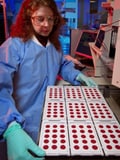Severe Combined Immunodeficiency (SCID)
Importance of Newborn Screening for SCID
 Babies born with Severe Combined Immunodeficiency (SCID) appear normal at birth but cannot fight infection. They may die before 1 year of age without medical treatment1. If SCID is diagnosed early in life, before the onset of infection, a bone marrow transplant can successfully treat the disorder.
Babies born with Severe Combined Immunodeficiency (SCID) appear normal at birth but cannot fight infection. They may die before 1 year of age without medical treatment1. If SCID is diagnosed early in life, before the onset of infection, a bone marrow transplant can successfully treat the disorder.
Newborn screening identifies babies with congenital disorders like SCID. Nearly 4 million newborns are screened annually in the U.S. for numerous diseases, and 32 states and the District of Columbia currently screen for SCID. CDC's Division of Laboratory Sciences has developed laboratory tests and reference materials for SCID using dried bloodspots and is working to advance screening nationwide.
State Screening
Shortly after a baby is born, a health professional takes a few drops of blood from the baby's heel. The blood sample is sent to a state laboratory to be tested for several severe disorders. Although each state decides which disorders are included in the screening, the Secretary's Advisory Committee on Heritable Disorders in Newborns and Children (SACHDNC) recommends states test for a core panel of 31 congenital disorders2. SCID was added to the core Recommended Uniform Screening Panel (RUSP) in 2010.
CDC Laboratory Program Activities
Since 2008, CDC has worked to increase the number of U.S states and territories that include accurate SCID testing as part of their newborn screening programs. In an effort to expand and improve screening, CDC's Division of Laboratory Sciences:
- Funds SCID test development and early screening in collaboration with states,
- Provides training and technical assistance to state labs screening for SCID,
- Develops new laboratory methods to identify babies with SCID,
- Provides testing materials to labs to help ensure accurate SCID screening, and
- Sponsors conferences and meetings to educate scientist about methods and reference materials for SCID testing.
CDC's Division of Laboratory Sciences funds SCID screening by state public health laboratories through cooperative agreements with newborn screening programs. Eligible state or territorial programs are those that have not previously conducted state-wide SCID newborn screening and demonstrate sufficient laboratory expertise, facilities, and legal authority to conduct screening. Awardees include:
- Louisiana, Nevada, and North Carolina (2015)
- Georgia, Virginia, and Oklahoma (2013)
- Michigan and Minnesota (2011)
- Wisconsin and Massachusetts (2008)
Successful newborn screening pilot studies in these states have:
- Ensured SCID screening tests were ready for nationwide use,
- Served as models for other states to implement population-based screening, and
- Provided evidence to support the addition of SCID to the RUSP.
In 2015, CDC funded New York to develop advanced laboratory screening techniques and quality assurance materials that will improve the detection of SCID.
SCID Program Outcomes
The primary goal of CDC's newborn screening program is to improve the health and lives of newborns. SCID newborn screening program activities continue to:

- Increase number of laboratories screening for SCID
- Increase number of babies screened for SCID
- Improve state laboratory capacity
- Improve state laboratory performance
CDC funding has helped states screen for more than one million babies for SCID. The Division of Laboratory Sciences continues to conduct proficiency testing programs with quarterly send outs to all U.S. laboratories currently screening for SCID.
References
- Clinical and Laboratory Standards Institute (CLSI). Newborn blood spot screening for severe combined immunodeficiency by measurement of T-cell receptor excision circles; Approved guideline. CLSI NBS06-A 2013.
- Selection of conditions based upon Newborn Screening: Towards a Uniform Screening Panel and System. Genetic Med. 2006; 8(5) Suppl: S12-S252 as authored by the American College of Medical Genetics (ACMG) and commissioned by the Health Resources and Services Administration (HRSA).
Get email updates
To receive email updates about this page, enter your email address:
Contact Us:
- Centers for Disease Control and Prevention
1600 Clifton Rd
Atlanta, GA
30329-4027 USA - 800-CDC-INFO
(800-232-4636)
TTY: (888) 232-6348 - Contact CDC–INFO


